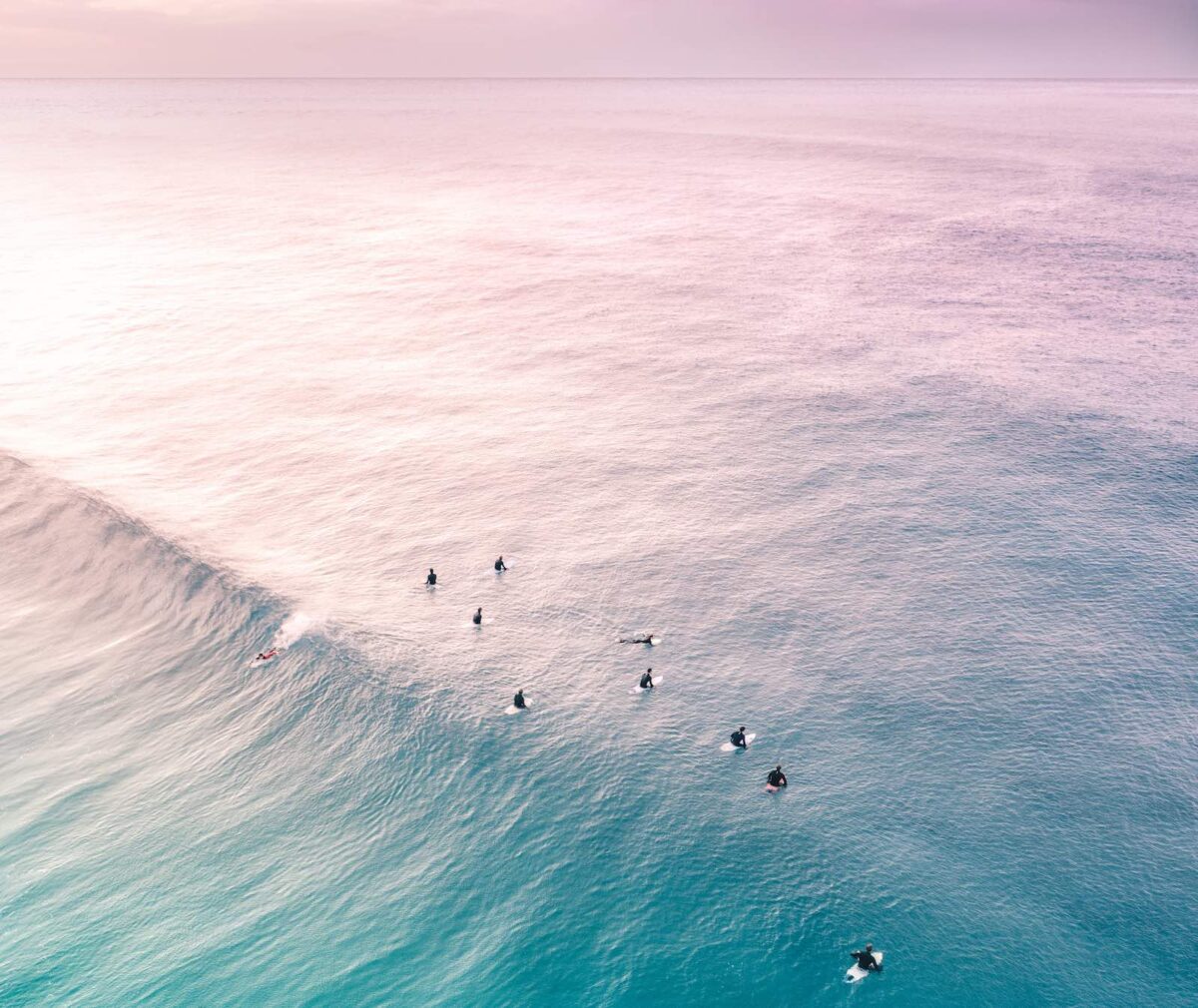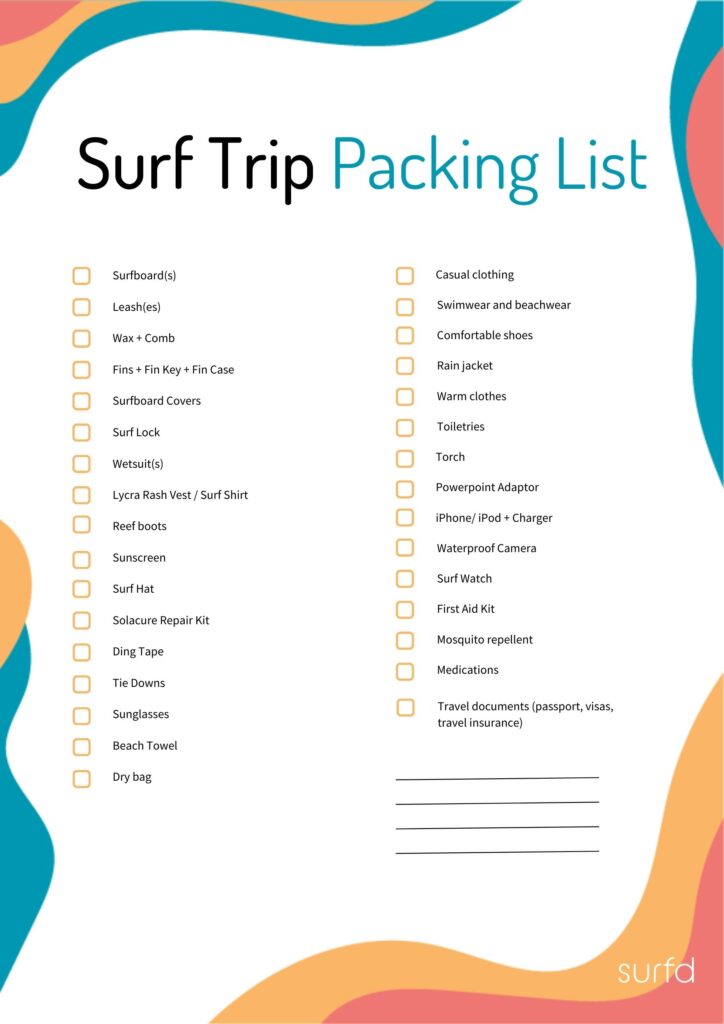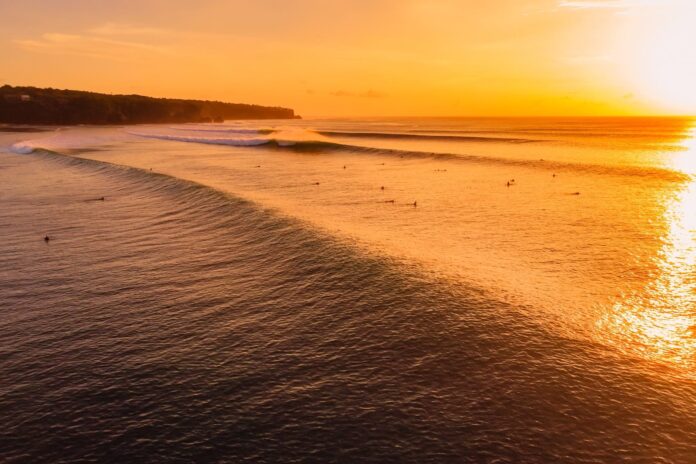One of the most exciting things we can do is intentionally embark on a journey into the unknown. This is especially true for surfers, who are always on the lookout for adventure, ideally with better waves than the ones they surf at home. Every surf trip offers opportunities to explore new places, face challenges, and grow as a person.
Travel is a bit of a mystery – it can be both exciting and scary at the same time. But there’s something special about the thrill of discovery while pushing ourselves to new limits. Unlike ‘normal people’, surfers don’t go on vacation to lounge on a sun-drenched beach. At least, that’s not the primary intention. Instead, we are fully focused on winds, tides, reef shapes, and swell directions. Our intention is to expend our energy riding walls of water—before lounging on a beach with a beer or cocktail. To normal holidaymakers, we’re an alien breed, covered in zinc, with salty hair, coffin-shaped luggage, and a language of our own.
Through surf travel, we find a connection with nature and a deeper understanding of ourselves.
Of course, it’s essential to feel prepared and ready for our surf trip. Knowing we have everything we need and are prepared for any challenge gives us the confidence to embrace the unknown. It’s this balance between being ready and stepping into the unknown that makes the surfing experience so thrilling.
Flow state—a peak experience of deep absorption and ego-lessness—can occur when we match our skills to a challenge. To do this, we need to prepare mentally, physically, and in terms of our equipment.
Let’s dive into preparing for that dream surf trip so that it is a dream rather than a nightmare. Below you will find a downloadable packing list if that’s all you need.
Deciding where to go
Choosing your next surf trip destination can be both an exciting and challenging task. With countless surf spots around the globe, the possibilities seem endless. To make the decision-making process a little easier, consider the following factors that can help you narrow down your options and find the ideal location for your next adventure.
- Skill level: The first factor to consider is your surfing skill level. Some surf spots are perfect for beginners, while others are better for experienced surfers. It’s essential to choose a destination that matches your abilities to ensure a safe experience for all. Research the breaks at potential locations to make sure they align with your skill level, and consider whether you’ll be looking for guidance or coaching during your trip.
- Weather and surf conditions: Different surf spots have different peak seasons and optimal conditions. Research the best time to visit your potential destination, considering factors such as swell consistency, wind, and water temperature. You’ll want to make sure that your chosen location offers the ideal conditions for your surf trip.
- Budget: Your budget is another critical aspect of choosing a surf destination. Consider the costs associated with traveling to and staying in various locations, as well as any additional expenses for boat trips, taxis, or car rentals. Some destinations may be more affordable than others, so keep your budget in mind when making your decision.
- Travel preferences: Think about the type of trip you want to have beyond the waves. Are you looking for a laid-back beach vacation or an action-packed adventure? Do you prefer a remote, off-the-beaten-path destination, or do you enjoy bustling beach towns with plenty of activities and nightlife? Reflecting on your travel preferences can help guide your choice and ensure your trip is both memorable and enjoyable.
- Local culture and experiences: Exploring new cultures and having unique experiences is a significant part of any travel adventure. Consider what each destination offers beyond surfing – such as local cuisine, sightseeing, history, and other activities. Choose a location that excites you and allows for personal growth and enrichment beyond the surf. Remember that even the best destination gets onshore and blown out, or goes flat for a spell. Keep your expectations in check. Remember that surf videos show the best of the best of the best!
- Duration of your trip: The length of your trip can also influence your choice of destination. If you have limited time, you may want to choose a location that’s closer to home or has shorter travel times. Conversely, if you have a more extended vacation, you might be more open to exploring remote or far-flung destinations.
Booking your trip
Taking these factors into account, spend some time researching various surf spots and reading reviews from fellow surfers who have visited the destinations you’re considering.
You’ll then need to consider how you actually book the trip. Will you use a travel agency or will you book it yourself? There are benefits to both approaches. We at Surfd prefer booking direct because you have more flexibility and can secure better deals.
However, if something goes wrong, you’ll have to contact different companies, sometimes with poor levels of real-time customer service. Please, please avoid websites like eDreams and GoToGate—just read Trustpilot reviews to see why.
Our favorite booking sites are:
Get your surf travel insurance
Travel insurance is an essential consideration for any surf trip, as it provides a safety net in case of unexpected events or mishaps. A comprehensive policy can cover medical expenses, trip cancellations or interruptions, lost or damaged luggage, and even emergency evacuation. When selecting a travel insurance plan, make sure it caters specifically to the needs of surfers.
Look for policies that cover surfing-related injuries and include coverage for your surfboard and other equipment. It’s crucial to read the fine print and understand the extent of the coverage, as well as any exclusions, limitations, or deductibles that may apply.
In our experience, most policies include water sports, whereas they do not include snow / winter sports by default. By investing in a suitable travel insurance policy, you can embark on your surf trip with peace of mind, knowing that you’re protected should the unexpected occur.
Some companies to check out include:

Preparing your surf gear
Next, you need to consider your surfing gear. This includes your surfboard, wetsuit, leash, wax, and fins. You should ensure that your surfboard is suitable for the waves you will be surfing and that it is in good condition. You may need to bring multiple boards if you plan to surf different types of waves. Your wetsuit should be appropriate for the water temperature, and you should bring a spare leash or two in case yours breaks. Additionally, you should bring sunscreen, a hat, and sunglasses to protect yourself from the sun.
In addition to your surf gear, you need to pack appropriate clothing for your trip. This includes casual clothing for when you are not surfing, as well as swimwear and beachwear. You should also bring comfortable shoes, a rain jacket, and warm clothes for colder climates.
Booking your surf accommodation
When planning a surf trip, choosing the right accommodation can make a significant difference in your overall experience. Comfort, convenience, and affordability are key factors to consider as you search for the perfect place to relax, unwind and socialize between surf sessions.
First and foremost, location is crucial. Opt for accommodation that is near the surf breaks you’re eager to explore—or at least within a reasonable distance. Proximity to the beach means more time spent in the water and less time commuting. Additionally, consider accommodations that offer easy access to shops, restaurants, and other attractions, which will enhance your overall experience during your downtime. This is especially important of you’re going with a non-surfing family.
Another aspect to consider when choosing your accommodation is the type of lodging that best suits your preferences and budget. Options range from budget-friendly hostels and surf camps to mid-range hotels and luxurious beachfront villas. If you’re traveling with a group of friends or fellow surfers, sharing a vacation rental or beach house can be a cost-effective and enjoyable option. When traveling solo or looking for a more social experience, surf camps or hostels often provide opportunities to meet like-minded individuals and make new connections. For examples of the different kinds of accommodation options available on a surf trip, check out our guide to places to stay for surfing Cloudbreak in Fiji.
As you evaluate your options, don’t forget to consider the amenities that matter most to you. Some accommodations may offer surfboard rentals, storage, or surf guides, which can be a significant advantage, especially if you’re new to the destination or type of waves on offer. Others might provide breakfast or communal kitchens, giving you the flexibility to prepare your own meals.
Once you’ve chosen your accommodation, it’s essential to think about transportation to the surf breaks. Depending on the location, you might be able to walk, boat or bike to the beach. However, in some cases, renting a car or using local public transportation may be necessary. If you decide to rent a car, make sure to choose a vehicle with sufficient space to store your surfboards and other equipment comfortably. Additionally, familiarize yourself with local traffic rules and customs to ensure a safe and smooth journey. Ensure your travel insurance will cover accidents and check if an international driver’s license is required.
In conclusion, selecting the right accommodation and transportation options for your surf trip can greatly enhance your overall experience. By considering factors such as location, type of lodging, amenities, and transport to the breaks, you can ensure that your surf trip is enjoyable, comfortable, and hassle-free.
Finally, you should ensure that you have all the necessary travel documents such as your passport, visas, and travel insurance. Store photos of all of these on your phone, especially if you don’t have roaming data for your destination! It’s also a good idea to bring a first aid kit, mosquito repellent, and any necessary medications.
Surf Trip Packing List
Here is a surf travel checklist to help you prepare for your trip:
- Surfboard(s)
- Leash(es)
- Wax + Comb
- Fins + Fin Key + Fin Case
- Surfboard Covers
- Surf Lock
- Wetsuit(s)
- Lycra Rash Vest / Surf Shirt
- Reef boots
- Sunscreen
- Surf Hat
- Solacure Repair Kit
- Ding Tape
- Tie Downs
- Sunglasses
- Beach Towel
- Wetsuit Dry bag
- Casual clothing
- Swimwear and beachwear
- Comfortable shoes
- Rain jacket
- Warm clothes
- Toiletries
- Torch
- Surf Watch
- Powerpoint Adaptor
- iPhone/ iPod + Charger
- Waterproof Camera
- First Aid Kit
- Mosquito repellent
- Medications
- Travel documents (passport, visas, travel insurance)
Download your Travel Checklist and tick as you pack.







